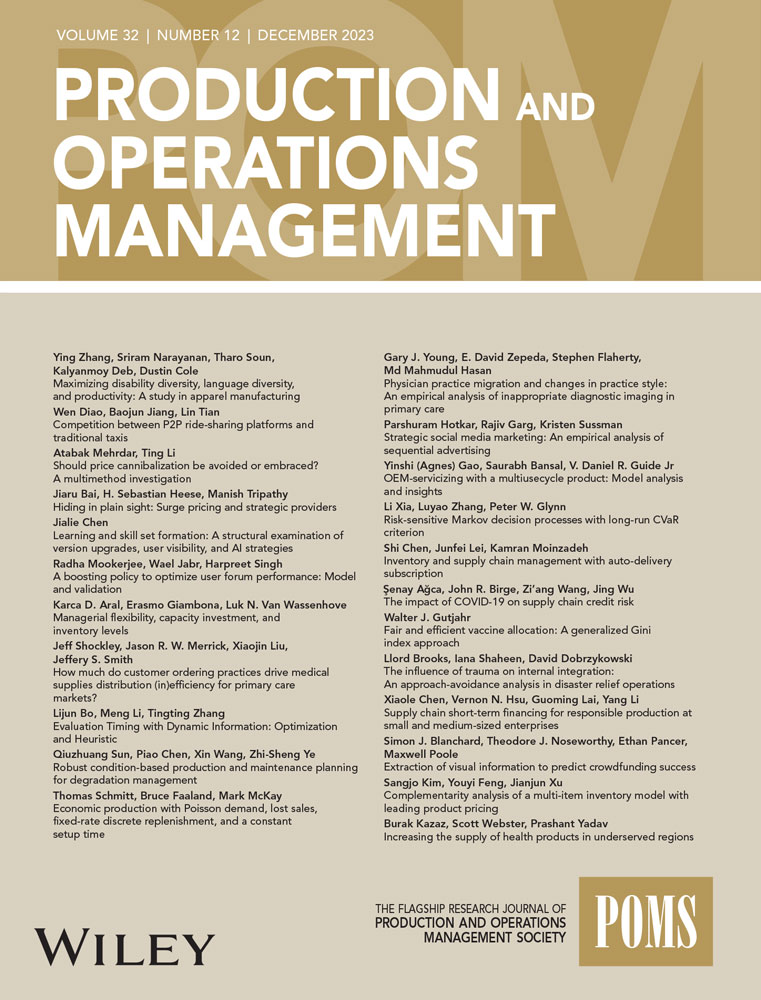关税配额下的全球农业供应链
IF 5.1
3区 管理学
Q1 ENGINEERING, MANUFACTURING
引用次数: 0
摘要
关税配额(TRQ)是全球农业贸易中广泛使用的市场准入工具,允许以比通常价格更低的关税进口预定数量的产品。本研究从运营管理的角度考察了TRQ系统的设计和管理,并分析了它们对市场准入、填充率和决策者收入的影响。我们研究了两种最常见的TRQ管理方法,即许可和先到先得(FCFS)系统。我们描述了进口商策略的纳什均衡,并观察了信息延迟和交付周期如何导致FCFS TRQ系统中许可证使用不足(即进口低于配额限制)和过度使用(即进口超过配额限制)。我们介绍了一个双TRQ系统,并证明了它优于许可证和FCFS系统。我们研究了通过海关保税仓库的库存选择以及物流渠道的选择对到达模式和填充率的影响。我们利用海关数据对英国和欧盟进口牛肉市场进行了案例研究。我们的数值研究解释了当前TRQ系统的次优性,并提出了对现有系统进行改造的建议。我们的研究结果为农业贸易商通过考虑TRQ系统的物流影响和了解其竞争对手来重新评估其供应链战略提供了实际指导。这项研究还敦促政策制定者在(重新)设计TRQ系统时采取综合方法,认识到供应链在全球农业贸易中的关键作用。本文受版权保护。保留所有权利本文章由计算机程序翻译,如有差异,请以英文原文为准。
Global agricultural supply chains under tariff‐rate quotas R.4
The tariff rate quota (TRQ) is a widely utilized market access instrument in global agricultural trade that allows a predetermined quantity of a product to be imported at a lower tariff rate than the usual rate. This study examines the design and administration of TRQ systems from an operations management perspective and analyzes their impact on market access, fill‐rates, and revenue for policy makers. We investigate the two most common TRQ administration methods, namely, licensing and first‐come, first‐served (FCFS) systems. We characterize the Nash equilibria of importers' strategies and observe how information delays and lead times can result in under‐utilization (i.e., imports being less than the quota limit) in licensing, and over‐utilization (i.e., imports exceeding the quota limit) in FCFS TRQ systems. We introduce a dual TRQ system and demonstrate its superiority over licensing and FCFS systems. We study the effects of stock‐keeping options through customs‐bonded warehouses and the choice of logistics channels on arrival patterns and fill‐rates. We conduct a case study of the UK and the EU imported beef market using customs data. Our numerical study provides an explanation for the sub‐optimality of the current TRQ systems and proposes modifications to transform the existing systems. Our findings offer practical directions for agricultural traders to reassess their supply chain strategies by considering the logistical implications of TRQ systems and understanding their competition. This study also urges policy makers to adopt an integrative approach in (re)designing TRQ systems, recognizing the pivotal role of supply chains in global agricultural trade.This article is protected by copyright. All rights reserved
求助全文
通过发布文献求助,成功后即可免费获取论文全文。
去求助
来源期刊

Production and Operations Management
管理科学-工程:制造
CiteScore
7.50
自引率
16.00%
发文量
278
审稿时长
24 months
期刊介绍:
The mission of Production and Operations Management is to serve as the flagship research journal in operations management in manufacturing and services. The journal publishes scientific research into the problems, interest, and concerns of managers who manage product and process design, operations, and supply chains. It covers all topics in product and process design, operations, and supply chain management and welcomes papers using any research paradigm.
 求助内容:
求助内容: 应助结果提醒方式:
应助结果提醒方式:


